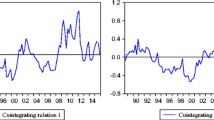Summary
This paper re-examines the relationships between short term capital flows and monetary policy, in the light of a new theoretical approach of the forward exchange market. They contend that the traditional forward exchange market theory is a misleading one as it fails to give all the importance it deserves to the distinction between covered and uncovered exchange transactions and to the actual role of the ‘arbitrageurs.’ As a consequence of this analysis, they demonstrate that the problem of monetary management in an open economy must be dealt with in a way different from what has been usual, and they conclude that monetary policy, central banks' intervention on the foreign exchange market and direct controls on capital movements can still have some efficiency in the struggle against inflation, either of the ‘domestic’ or the ‘imported’ type.
Similar content being viewed by others
References
Anonymous, ‘Break-up of the World Money Market,’The Banker, XXIII (1973), pp. 454–455.
Argy, V. andM. G. Porter, ‘The Forward Exchange Market and the Effects of Domestic and External Disturbances under Alternative Exchange Rate Systems,’IMF Staff Papers, XIX (1972), pp. 503–532.
Argy, V. andZ. Hodjera, “Financial Integration and Interest Rate Linkages in the Industrial Countries,’IMF Staff Papers, XX (1973), pp. 1–77.
Berger, P., ‘Interdépendance entre les mouvements de devises et les variations des crédits bancaires,’ inMonnaie et Balance des Paiements, Paris 1972 (Papers and proceedings of a meeting held at the Banque de France on May 19–21, 1969).
Berger, P., ‘Rapports entre l'évolution de la balance des paiements et l'évolution de la liquidité interne,’ inMonnaie et Balance des Paiements, cited under [4].
Bourguinat, H.,Marché des changes et crises des monnaies, Paris, 1972.
Captain Hook, ‘Offshore Banking,’Euromoney, 1973, p. 17.
Coombs, C. A., ‘Treasury and Federal Reserve Foreign Exchange Operations,’Monthly Review of the Federal Reserve Bank of New-York, 1973, pp. 215–231.
Coulbois, P., ‘Réflexions sur le change à terme,’Banque, xxxxvii 1972, pp. 553–560.
Coulbois, P. (ed.),Le change à terme: technique, théorie, politique, Paris, 1972 (Papers and Proceedings of the Round Table held in Paris on April 17–19, 1972).
Delfaud, P., ‘Le change à terme, réflexions sur un colloque,’Revue de Science Financière, 1972, pp. 193–206.
Einzig, P.,A Dynamic Theory of Forward Exchange, London, 1961.
Holtrop, M. W.,Money in an Open Economy, Leiden, 1972.
Levin, J. H.,Forward Exchange and Internal-External Equilibrium, The University of Michigan, 1970.
Llewellyn, D. T., ‘How to control Capital Flows?,’The Banker, CXXIII (1973), pp. 764–768.
Mckinnon, R. I., ‘Monetary Theory and Controlled Flexibility in the Foreign Exchanges,’ inStabilization Policies in Interdependent Economies, (E. Claassen and P. Salin, eds.), Amsterdam, 1972.
Mundell, R. A., ‘The Monetary Dynamics of International Adjustment under Fixed and Flexible Exchange Rates,’Quarterly Journal of Economics, LXXIV (1960), pp. 227–257.
Mundell, R. A., ‘The Appropriate Use of Monetary and Fiscal Policy under Fixed Exchange Rates,’IMF Staff Papers, IX (1962), pp. 70–79.
O.E.C.D., ‘Restrictions sur les mouvements de capitaux: l'escalade récente,’Perspectives Economiques, 1972, pp. 76–84.
O.E.C.D., ‘La transmission internationale de l'inflation,’Perspectives Economiques, 1973, pp. 89–106.
Prissert, P., ‘La théorie générale du marché des changes à terme; analyses économiques et réalités techniques,’ inMonnaie et balance des paiements, cited under [4].
Prissert, P., ‘Vers une remise en question fondamentale de la théorie académique des changes à terme?,’Banque, XXXXVII (1972), pp. 333–343.
Prissert, P., ‘Capitaux à court terme, euro-dollar et politiques monétaires,’ Economce Appliquée, xxv (1972), pp. 299–323.
Sohmen, E.,Flexible Exchange Rates, Chicago, 1969.
Spraos, J., ‘Speculation, Arbitrage and Sterling,’Economic Journal, LXIX (1959), pp. 1–21.
Swoboda, A. K., ‘Equilibrium, Quasi-Equilibrium and Macroeconomic Policy under Fixed Exchange Rates,’Quarterly Journal of Economics, LXXXVI (1972), pp. 162–171.
Swoboda, A. K., ‘Monetary Policy under Fixed Exchange Rates: Effectiveness, the Speed of Adjustment and Proper Use,’Economica, XXXX (1973), pp. 136–154.
Tsiang, S. C., ‘The Theory of Forward Exchange and Effects of Government Intervention on the Forward Exchange Market,’IMF Staff Papers, VII (1959), pp. 75–106.
Author information
Authors and Affiliations
Rights and permissions
About this article
Cite this article
Coulbois, P., Prissert, P. Forward exchange, short term capital flows and monetary policy. De Economist 122, 283–308 (1974). https://doi.org/10.1007/BF01680112
Issue Date:
DOI: https://doi.org/10.1007/BF01680112




